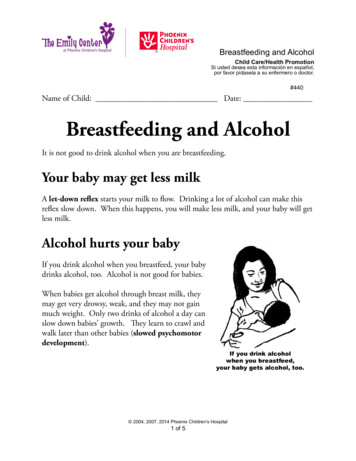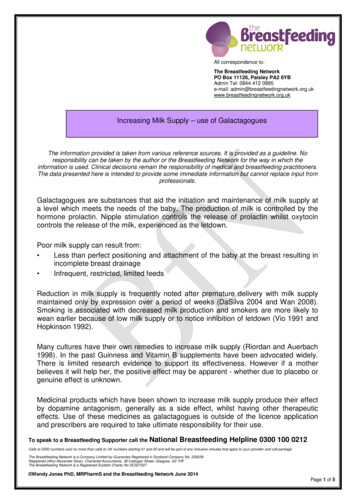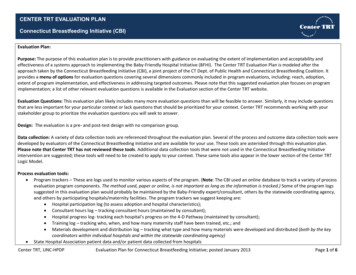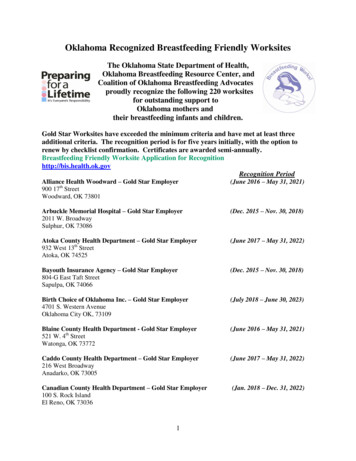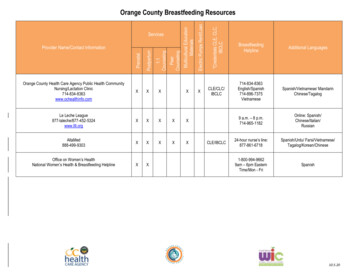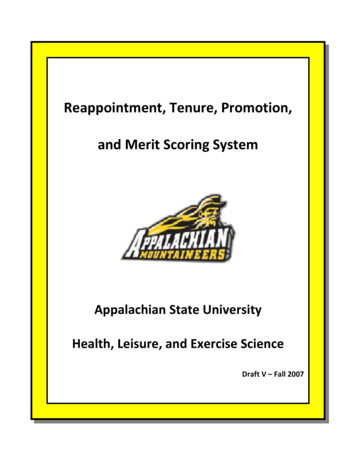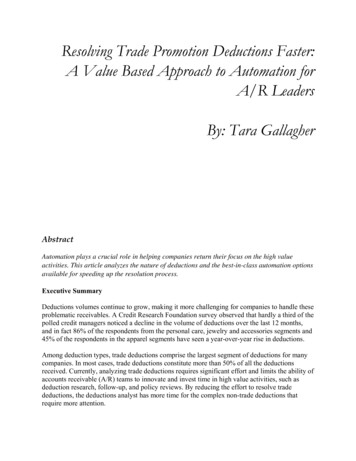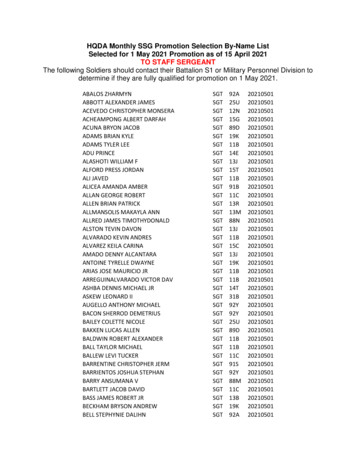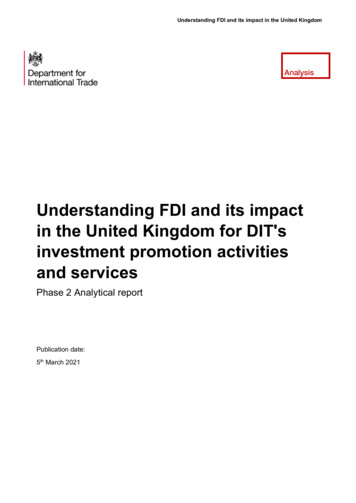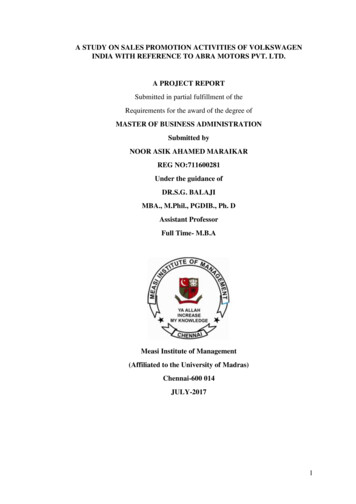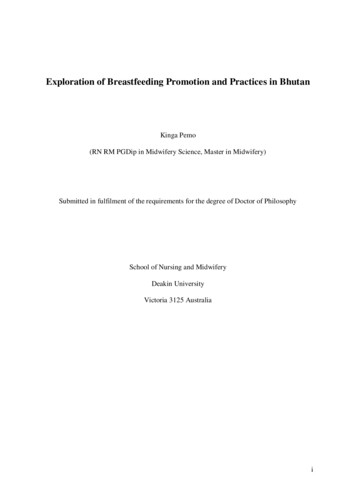
Transcription
Exploration of Breastfeeding Promotion and Practices in BhutanKinga Pemo(RN RM PGDip in Midwifery Science, Master in Midwifery)Submitted in fulfilment of the requirements for the degree of Doctor of PhilosophySchool of Nursing and MidwiferyDeakin UniversityVictoria 3125 Australiai
Signature Redacted by Library
Signature Redacted by Library
AcknowledgementsI am immensely grateful to Deakin University for awarding me the scholarship for myPhD degree, without which I would have never achieved my dream of undertaking a PhDcourse. In the course of my PhD journey, I have also sought support and guidance from manyother organisations and individuals, to whom I am thankful. I would like to offer my specialgratitude particularly to my magnanimous and erudite supervisors, Associate Professor DianePhillips and Professor Alison Hutchinson. They are the best supervisors I could have everwished for. I would not have been able to undertake this PhD journey without their staunchand unwavering support and guidance throughout my course. Associate Professor DianePhillips always had time for me. I could go and knock on her door any time and be greetedwith a welcoming smile! Her ‘onwards and upwards’ slogan kept me going! And with justone word from Professor Alison Hutchinson, who humanised the statement ‘less is more’, allmy problems would fall into place! Thank you once again, my eminent professors.I also like to thank from the depth of my heart Barbara Green, who is the internationalcoordinator at Deakin University and a very close personal friend of mine in particular andfor Bhutanese people in general. You are a person to whom I could run for help and supportany time. Not to forget, I also thank you for going through my thesis despite your busyschedule.Special thanks go to all my friends and colleagues in the Faculty of Nursing andPublic Health, Khesar Gyalpo University of Medical Sciences of Bhutan, who encouragedme, especially my Dean, Dr Chencho Dorjee, Madam Sangay Pem, Madam Renuka Motheyand Dr Ripa; I thank you all for taking a personal interest in looking after my family whenthey needed medical attention back home. Many thanks to Tandin Pemo, NursingSuperintendent of Jigme Dorji Wangchuck National Referral Hospital, Dr Ugyen Sonam,Head of Department of Community Health, and Geeta Giri, Yangdon Paki and Tsheringiv
Yangchen, in-charges of the Maternity Ward, Birthing Centre and Reproductive Health Unit,respectively. My unexpected source of support the past year has been my friend RussLayman, a person who has taken it on himself to be my ardent supporter to see that Icomplete my PhD. Thank you, Russ, for your support and encouragement.My thanks and everlasting gratitude to my father, Phuntsho, and my mother, DawaZangmo, who had to become parents yet again to look after my children. My warmest thanksto my siblings, Tashi Tshering, Choening Dorji, Kesang Dema and Sangay Zangmo, and theirrespective spouses, Dechen, Pema, Dorji and Thupten, for helping to take care of mychildren. My thanks to my father-in-law, Ugyen Namgyal, and mother-in-law, NamgayWangmo, for all their support and encouragement.Being a part of a large family, it is impossible to mention each and every one, but Iwould like to thank all my relatives and friends who have helped out in some way, and myspecial thanks and respect to my maternal uncle, Lhundrup Dorji, for his spiritual guidanceand support. My love and thanks to my daughter, Sampem Yeshey Tshomo, and two sons,Pemachan Yeshey Dorji and Choying Yeshey Jigme, for staying healthy and happy despitetheir parents’ absence from their lives for the last four years. Mummy and Daddy areextremely sorry they were not there for you when you needed us, but we knew you all werein good hands if not better ones. And my love and thanks to my biggest critic, my punchingbag, my cook and the person who has been with me through the highs and lows of thejourney, my husband, Tshewang Yeshey.Finally, I would like to thank all the women, midwives, obstetricians, paediatricians,health assistants and the Program Officer who participated in this study. Without theirparticipation, this study would not have been possible.v
This thesis has been professionally edited by Mary Josephine O’Rourke AE,Accredited Editor, Institute of Professional Editors, Vice-President and Freelance AffairsOfficer, Editors Victoria.vi
AbstractBackground: Because of the protective properties of human breastmilk, the World HealthOrganization (WHO) recommends exclusive breastfeeding (EBF) of babies from soon afterbirth for six months and with continued breastfeeding along with appropriate complementaryfoods up to two years of age or beyond. Breastfeeding has been promoted by the RoyalGovernment of Bhutan since 1990, but this has resulted in a suboptimal increase in EBF.Bhutanese women’s perceptions and intentions regarding breastfeeding and theirbreastfeeding practices, however, have not been explored. Health professionals and their rolein breastfeeding education, promotion and support of women and their families has not beenexplored either.Purposes: The first purpose of this study was to explore Bhutanese women’s perceptions ofand their intentions related to their baby’s nutrition after birth, knowledge about EBF duringpregnancy, and their perceptions, experiences and breastfeeding practices six weeks afterbirth. The second purpose was to explore health professionals’ knowledge and promotion ofEBF and the level of breastfeeding support they provided to women.Design: A Qualitative Exploratory Descriptive research design has been adopted for thestudy. Purposive sampling was used to include childbearing women (interviewed twice) andhealth professionals (interviewed once). The setting was Jigme Dorji Wangchuck NationalReferral Hospital (JDWNRH) in Thimphu, Bhutan. Because some of the women did notspeak English, a semi-structured guide for the interviews with them was pre-tested tominimise the loss and misinterpretation of data. Most of the interviews with the women wereconducted in Dzongkha, the national language of Bhutan, while all interviews with healthprofessionals were conducted in English. The student researcher is fluent in both English andvii
Dzongkha. Framework analysis was used to identify the themes from the individualinterviews.Methods: Digitally recorded individual interviews were conducted with 25 multigravidae and24 primigravidae women at the term of pregnancy. The women were interviewed again at sixweeks following birth, when 22 multiparae and 22 primiparae participated in interviews. Fivewomen, three multiparae and two primiparae, were unavailable for the second interview. Atotal of 38 semi-structured interviews were conducted with health professionals, consisting of26 midwives, four obstetricians, four paediatricians, three health assistants and one ProgramOfficer.Findings: Five themes and 13 sub-themes emerged from the interviews with women at theterm of pregnancy. The five themes that emerged from the interviews with pregnant womenare: 1) previous breastfeeding experiences and influencing factors; 2) compulsorybreastfeeding; 3) perceptions and knowledge about breastfeeding; 4) understandings andviews on breastfeeding and exclusive breastfeeding; and 5) breastfeeding informationprovided by health professionals. Five themes, comprising 13 sub-themes, emerged from theinterviews with women at six weeks following childbirth: 1) current breastfeeding practices;2) Bhutanese women’s breastfeeding experiences and intention to continue; 3) culture,traditions and beliefs affecting breastfeeding practices; 4) hospital practices affectingbreastfeeding; and 5) perceptions of breastfeeding support. Overall, the women exhibitedpositive attitudes towards breastfeeding and intended to breastfeed their babies because theyknew about the benefits of breastmilk and were influenced by Bhutanese social, traditionaland cultural norms.The findings of the study indicate that factors such as a lack of breastfeeding information andsupport during pregnancy and following birth led to women having limited understanding ofviii
the true meaning of EBF. They, therefore, turned to their family and friends for breastfeedingadvice, information and support when they faced breastfeeding problems. Furthermore, theyadopted cultural and traditional practices in the belief that such practices would not impedethe exclusivity of breastfeeding. Most of the time, these cultural and traditional practiceswere encouraged and/or imposed by elders in the family. Women who planned to return towork were not informed about any options to support continuation of EBF and hence plannedto apply non-exclusive breastfeeding by supplementing their breastmilk with formula andother commercial foods.Seven themes with 24 related sub-themes emerged from the interviews with healthprofessionals: 1) knowledge of EBF and current breastfeeding status in Bhutan; 2)breastfeeding is a social norm in Bhutan; 3) barriers to initiation of breastfeeding; 4) reasonsfor breastmilk supplementation; 5) barriers to breastfeeding promotion activities; 6) strategiesto improve the EBF rate; and 7) breastfeeding support and promotion activities. They allunderstood and supported EBF. Although some of the health professionals were not aware ofall ten steps, they were, however, supportive of the elements of the Baby-Friendly HospitalInitiative’s the Ten Steps to Successful Breastfeeding. All the health professionals reportedstaff shortages and heavy workloads. In particular, midwives, who were the frontline carersfor women, reported a lack of ongoing professional development about breastfeeding, whichreportedly hindered them from promoting and supporting breastfeeding in women. Otherfactors interfering with breastfeeding and EBF promotion included the loss of JDWNRH’sBaby-Friendly designation and an outdated National Breastfeeding Policy.Conclusion and recommendations: Childbearing women relied on family, elders andfriends for guidance related to breastfeeding; therefore, a recommendation resulting from thisstudy is that formalised programs on breastfeeding education and promotion should be madeavailable to women during pregnancy and immediately after birth. Women require supportix
services related to breastfeeding and EBF in the face of possible breastfeeding problems andwhen they return to their workplace. It was commonly reported that lack of updates inbreastfeeding knowledge and skills hampered midwives in providing effective breastfeedingpromotion and EBF support. Thus, a further recommendation is that health professionals, inparticular midwives, should be given regular and ongoing professional development.Midwives are well placed to provide formal programs on breastfeeding and EBF across thechildbearing continuum for women and their families, including elders. An organisationalreview of staffing and workloads for all health professionals, particularly for midwives, isalso recommended, including the establishment of a model of maternity care that placesemphasis on quality care for women, their babies and their families. Furtherrecommendations include regular reviews and updates of the National Breastfeeding Policy,developed according to the WHO recommendation, and application by JDWNRH for redesignation and re-accreditation as a Baby-Friendly Hospital.x
Table of ContentsAcknowledgements . ivAbstract . viiTable of Contents . xiList of Tables . xxiList of Figures . xxiiAbbreviations .xxiiiGlossary . xxivCHAPTER 1: INTRODUCTION . 11.1Introduction . 11.2Experiences as a breastfeeding mother . 11.3 Metamorphosis of my perceptions of breastfeeding and generation of interest in thestudy . 21.4Background . 51.4.1World Health Organization’s recommendation for EBF. 51.4.2Breastfeeding promotion in Bhutan . 71.4.3Significance of the study . 81.5Study aims . 101.6Study purposes . 101.7Study questions . 111.8Study impact . 111.9Overview of the thesis . 121.10Conclusion . 12CHAPTER 2: THE KINGDOM OF BHUTAN . 132.1Introduction . 132.2Country profile . 132.3Understanding Bhutanese society . 152.4Government and its pledge . 162.5Maternity leave in Bhutan . 172.6Health services in Bhutan . 172.7Hospital profile. 182.8Midwifery-trained personnel in Bhutan . 192.9Maternity services and staffing pattern in JDWNRH . 20xi
2.9.1The Reproductive Health Unit of JDWNRH . 202.9.1.1Antenatal Clinic . 202.9.1.2Postnatal Clinic. 212.9.1.3Well-Baby Clinic. 212.9.2Birthing Centre . 222.9.3Maternity Ward . 222.10The maternity care pathway at JDWNR Hospital . 222.10.1Antenatal care . 222.10.2Intranatal care . 232.10.3Postnatal care. 232.11Conclusion . 24CHAPTER 3: LITERATURE REVIEW . 253.1Introduction . 253.2An overview of breastfeeding, exclusive breastfeeding and their promotion . 263.2.1Maternal benefits. 263.2.2Benefits for babies . 263.2.3Exclusive breastfeeding rates . 273.3Baby-Friendly Hospital Initiative . 293.3.13.4Implementation of Baby-Friendly Hospital Initiative . 31Factors influencing initiation and duration of breastfeeding . 343.4.1Maternal factors . 343.4.1.1Women’s intention to breastfeed. 343.4.1.2Maternal attitude towards breastfeeding . 373.4.1.3Maternal self-efficacy and association with breastfeeding . 383.4.1.4Women’s understanding and knowledge of breastfeeding . 393.4.1.5Maternal demographic factors affecting breastfeeding. 413.4.1.5.1 Age . 413.4.1.5.2 Parity . 423.4.1.5.3 Educational status . 443.4.1.5.4 Working women . 453.4.2Influence of maternal breast conditions on breastfeeding . 483.4.3Influence of baby-related factors on breastfeeding . 493.4.3.1Sick babies and breastfeeding . 50xii
3.53.4.3.2Jaundice and breastfeeding . 513.4.3.3Temperamental/fussy babies . 52Organisational and hospital factors affecting breastfeeding . 533.5.1Antenatal practices and their association with breastfeeding. 533.5.2Intrapartum practices associated with breastfeeding . 563.5.2.1Caesarean section . 573.5.2.2Analgesia during labour .
School of Nursing and Midwifery Deakin University Victoria 3125 Australia . iv . gratitude particularly to my magnanimous and erudite supervisors, Associate Professor Diane . Institute of Professional Editors, Vice-Presi
